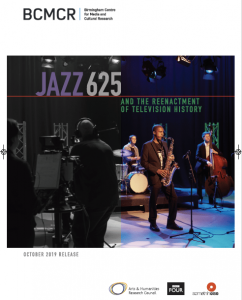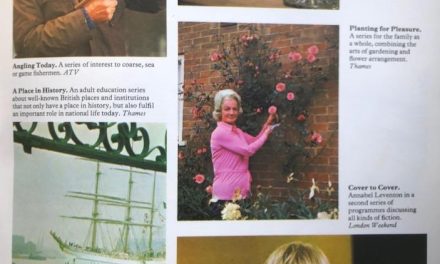The last two years have been both luxurious and difficult. Luxurious, because the award of an AHRC ECR Research Leadership Fellowship gave me the freedom to work on a dream project. Difficult, because the slow decline and death of my father ran in parallel to that award. Sometimes – as I struggled to meet my commitments to work and family – that dream felt like a nightmare.
It was, then, with some relief that I found myself welcoming forty delegates to my end-of-project conference at the start of this month. The audience was a good mix of academics, musicians, promoters, television professionals, jazz historians, television historians and interested members of the public. We were also celebrating two publications: Jazz Research Journal 12:1 (the first academic journal dedicated to jazz and television) and the end of project report Jazz 625 and the Reenactment of Television History.

Fig. 1: An online version of the report is downloadable here.
My opening lecture, Some Histories of Jazz Television, aimed to unpick a few of the prevalent narratives that have plagued the popular memory of 1960s jazz programming and to suggest new ways of approaching this material. It was also an opportunity for me to thank two colleagues who have mentored me throughout the last five years – Professor Tim Wall and Professor Nicholas Gebhardt – and to describe the generosity of my project interviewees: producers, directors, soundmen, videotape editors, set carpenters, audience members during OB recordings and musicians.
My fellowship had aimed to stimulate new work from those working on jazz and television. And so we were privileged to hear from academics and students at various stages of their careers, describing work that will set the agenda for the future of the field: Will Finch on Arena’s jazz documentaries, Liam Maloy on jazz in Jim Henson shows, Regan Bowering on the relationships between iconography and materiality in album covers, Peter Dawn on the jazz biography, Alex Gagatsis on the Modern Jazz Quartet onscreen and in images, and Tim Wall on Jazz Britannia.
To conclude, a panel discussed the future of jazz television. Unfortunately, travel difficulties on the day prevented Jazz 625 Live producer Janie Valentine from joining us but our conversation was still extremely productive. Between them, Xhosa Cole (Jazz 1080, BBC Young Jazz Musician of the Year 2018), Robert Mitchell (musical director, Jazz 625 Live) and Marcus Viner (director, Jazz 625 Live) set out the possibilities for jazz in the current arts broadcasting landscape.
While the project is drawing to an end, the day prompted a number of interesting possibilities for the future. Opportunities are opening up next year for new programme-making, new archival initiatives and new ways of publishing television history. Let’s hope that this time family life will remain calm as I pursue these.
Dr Nicolas Pillai is a research fellow at Birmingham City University. With Dr Katherine Williams he is co-editor of Jazz Research Journal. He is currently working on the edited collection Rethinking Miles Davis for Oxford University Press.






